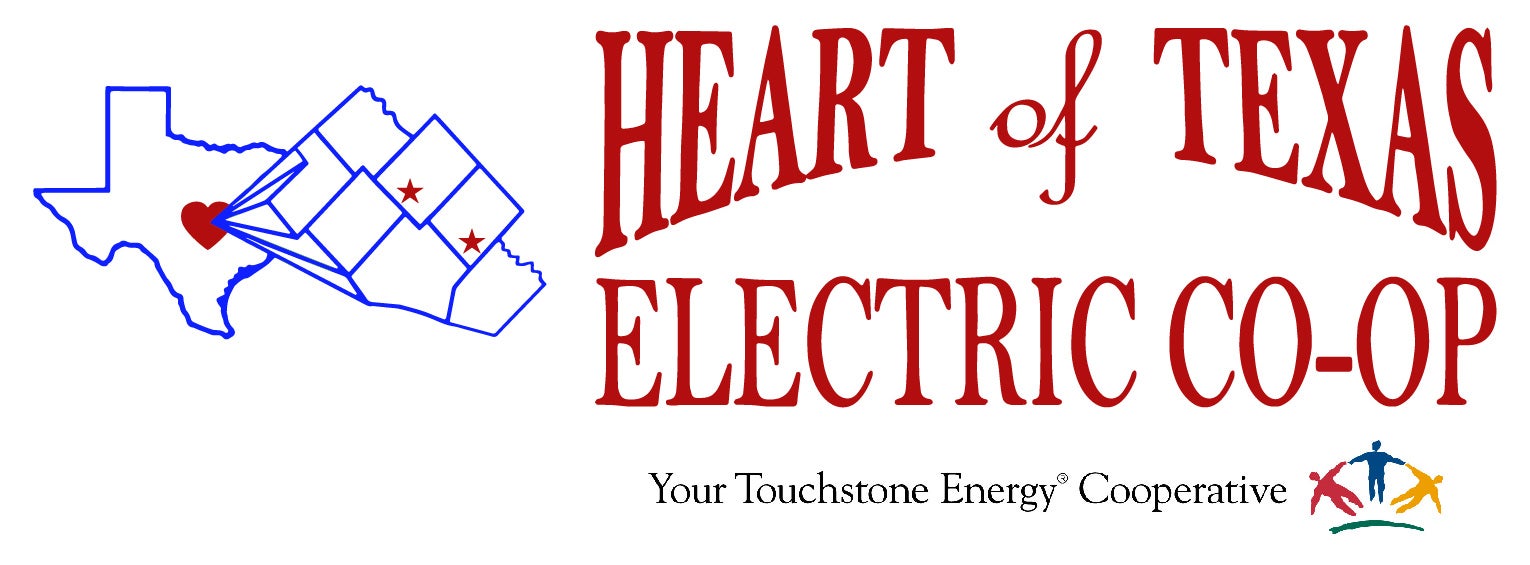 Welcome to our new Energy Solutions page, a space dedicated to everything you need to know about energy at Heart of Texas Electric Cooperative. We are committed to helping you save as much as possible on your electric bill with us as the market plays out in real time.
Welcome to our new Energy Solutions page, a space dedicated to everything you need to know about energy at Heart of Texas Electric Cooperative. We are committed to helping you save as much as possible on your electric bill with us as the market plays out in real time.
On this page, you will learn more about energy costs, we'll deliver to you the most up-to-date data highlights of the industry and we'll help you understand more about ERCOT, including it's current grid conditions, along the way.
Also, are you thinking about solar energy and whether it would be right for your family or business? We can help with that, too.
We understand our Members are experiencing higher electric bills. This is due to the steep increase in natural gas prices, which are currently at a 7-year high, and winter weather causing greater kWh energy consumption.
Our nation is experiencing levels of inflation not seen in decades. As a result, you have undoubtedly been impacted at the grocery store, gas station, hardware store, and everywhere else you transact business.

WTI crude oil futures price
7/18/2022: $104.48/barrel
up $34.80 from year earlier
Natural gas futures price
7/19/2022: $7.35/MMBtu
Up $3.62 from year earlier
Retail gasoline price
7/25/2022: $4.33/gal
Up $1.19 from year earlier
Retail diesel price
7/21/2022: $5.27/gal
Up $1.93 from year earlier
Source: U.S. Energy Information Administration
The ERCOT market is very sensitive to the price of natural gas. As you see in the image below, the market’s thermal capacity to generate electricity is driven by natural gas supply. With 47.45% of ERCOT’s generating resources driven by natural gas, it is a fact when natural gas prices rise, so will the cost of electricity.
At HOTEC, We remain committed to delivering you electricity and continue to do everything within our power to keep your energy delivery cost as low as possible, but unfortunately, we have no means to lower the commodity prices for these energy resources vital to generating power.
We are hopeful these commodity prices will decrease soon, and this will relieve some of the economic distress everyone is currently experiencing.

The Electric Reliability Council of Texas (ERCOT) manages the flow of electric power to more than 26 million Texas customers representing about 90 percent of the state’s electric load. As the independent system operator for the region, ERCOT schedules power on an electric grid that connects more than 52,700+ miles of transmission lines and 1,030+ generation units, including Private Use Networks. It also performs financial settlement for the competitive wholesale bulk-power market and administers retail switching for 8 million premises in competitive choice areas. ERCOT is a membership-based 501(c)(4) nonprofit corporation, governed by a board of directors and subject to oversight by the Public Utility Commission of Texas and the Texas Legislature. Its members include consumers, cooperatives, generators, power marketers, retail electric providers, investor-owned electric utilities, transmission and distribution providers and municipally owned electric utilities.
Supply and Demand is a graphical representation of the ERCOT system’s current power supply (capacity) and demand using Real-Time data, as well as projected power supply (capacity) and demand from hourly forecasts.
The Grid Conditions dashboard has two displays: Operating Reserves and Daily PRC. The Operating Reserves meter shows the current state of grid conditions as well as the amount of operating reserves. The Daily PRC graph shows both recent and current Physical Responsive Capability (PRC), which is the total amount of frequency responsive Resource capability On-Line in Real-Time.
Combined Wind and Solar is a graphical representation of estimated wind and solar power production amounts for the Current Operating Day and the Next Day.
Did you know? Heating & Air Conditioning are usually the largest loads in a home and responsible for 40 to 50% of your monthly energy spend.
- Set thermostats to 78F in summer, 68F in winter.
- Install a programmable thermostat to save even more.
- Run ceiling paddle fans on medium, blowing down in summer and paddle fans on low, blowing up in winter.
- Turn off ceiling fans when leaving the room. Fans cool people, not rooms.
- When installing new air filters, make sure they are facing in the correct direction (look for arrow on side of filter).
- When heating or cooling, keep windows locked.
- Insulate electric wall outlets and wall switches with foam pads.
- Caulk along baseboards with a clear sealant.
- Caulk around plumbing penetrations that come through walls beneath bathroom and kitchen sinks.
- Caulk electrical wire penetrations at the top of the interior walls in the attic.
- Close shades and drapes at night to keep heat in during the winter.
- Make sure drapes and shades are open during the day to catch free solar heat in winter.
- Ensure attic access door closes tightly and is insulated.
- Make sure insulation in your attic does not block soffit vents.
For more tips, visit Touchstone Energy.
Did you know? The kitchen can amount to 15-20% of your monthly energy use, which includes appliance use and refrigeration.
- Turn off coffee makers when not in use.
- Use your refrigerator’s anti-sweat feature only if necessary.
- Switch your refrigerator’s power-saver to “ON,” if available.
- Clean refrigerator coils annually.
- Regularly defrost refrigerator or freezer to avoid ice buildup.
- Set the refrigerator temperature to 34 to 37F and freezer temperature to 0 to 5F.
- Unplug unused refrigerators or freezers. Recycle them if you do not need them.
- Use microwave for cooking when possible.
- When cooking on the oven range, use pot lids to help-food cook faster.
- If you are heating water on the stove, use hot tap water instead of cold.
- Remember to use the kitchen exhaust fan when cooking. Turn it off after cooking.
- Use a slow-cooker instead of simmering foods on the stove.
- If rinsing dirty dishes before putting them into the dishwasher, do so with cold water.
- Use cold water for garbage disposal.
- Only run dishwasher when fully loaded.
Did you know? Other plug loads around the home can add up to be 8-10% of monthly energy use.
- Turn computers and monitors off when not in use.
- When buying a new computer, consider buying a laptop.
- It uses less energy than a comparable desktop.
- Turn large-screen TVs off completely when not in use.
- Check for energy saving settings on flat-panel TVs like automotive brightness control and a power saving sleep mode.
- Request an ENERGY STAR® set-top box from cable or satellite provider.
- Turn off stereos and radios when not in use.
- Enable auto power down feature on gaming consoles.
- If you don’t unplug them, use energy-saving modes or automatic sleep function on electronics.
- Remember to turn off hair curling irons and hot rollers.
- Make sure electric blankets are turned off in the morning.
- Ensure all new appliances, electronics and lights are ENERGY STAR® labeled.
- Turn off pool pumps and heaters when not needed.
- Verify livestock water tank heaters are off when not needed.
- Make sure heat tape is off when not needed.
- Unplug battery chargers when not needed.
Did you know? Traditional lighting can amount up to 12% of your monthly energy use. Energy saving light bulbs can slice lighting costs by 75%.
- Replace outdoor lighting with its equivalent outdoor-rated LED bulb. LED’s work well in cold weather
- Use fixtures with electronic ballasts and T-8, 32-watt fluorescent lamps.
- Use outdoor security lights with a photocell and/or a motion sensor.
- Turn off unnecessary lighting.
Note: A lumen is a unit used for the measurement of visible light. A traditional 60 Watt light bulb produces 800 lumens. See the chart below to see how many Watts other bulbs use to produce the same amount of light.
Did you know? Water Heating can amount to 12% of your monthly energy use.
- For households with 1 or 2 members, a 115F setting may work fine.
- Install water heater wrap, also known as water heater blanket, per manufacturer’s instructions.
- Drain 1-2 gallons from bottom of water heater each year to reduce sediment build up.
- Install heat traps on hot and cold water lines when it’s time to replace your water heater.
- Insulate exposed hot water lines.
- Limit shower length to 5-7 minutes.
- Install water saving shower heads.
- Fix dripping faucets.
- Don’t let water run while you are shaving or brushing your teeth.
